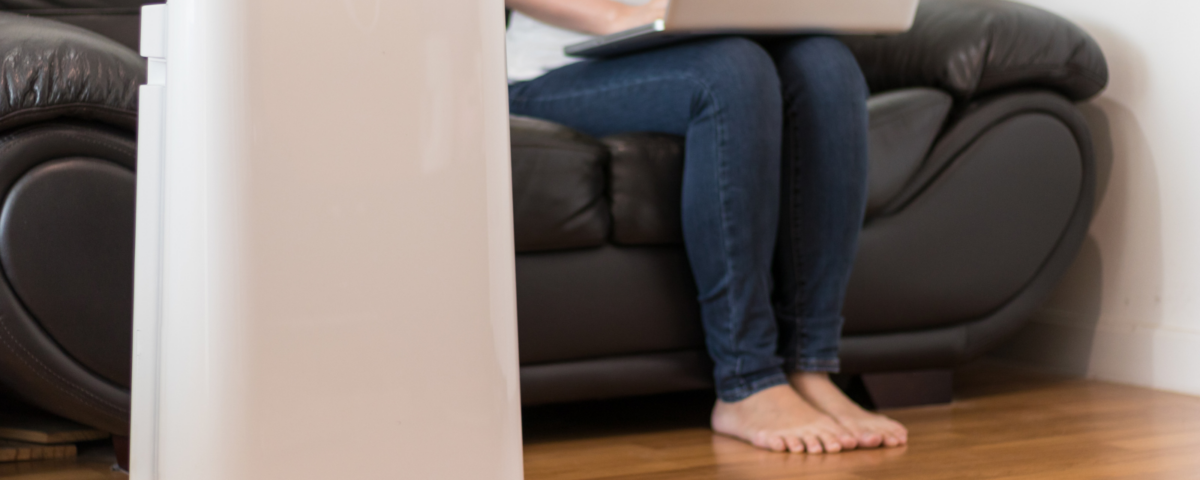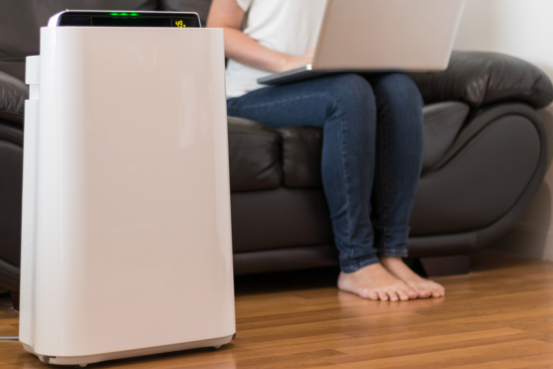Air pollution is one of the major risk factors for serious diseases and premature death, and as most Europeans spend over 90% of their lives indoors, a good indoor climate is important. That’s why Green Transition Denmark (a Coolproducts member), the Danish Technological Institute and the Danish Consumer Council have carried out a study on the ability of 28 air purifiers to remove particles, volatile organic compounds and viruses.
The Danish Technological Institute, the Danish Consumer Council and Green Transition Denmark have just completed a major study on the ability of 28 air purifiers to remove particles, volatile organic compounds and viruses. At the same time, electricity consumption and noise levels were measured, as well as the air purifiers’ possible production of harmful ozone. The results provided new knowledge about the different technologies in air purifiers, and are a great help for potential buyers, as the market for air purifiers is opaque.
Background
Air pollution is one of our major risk factors for serious diseases and premature death, and as most Europeans spend more than 90% of their lives indoors, a good indoor climate is important. Clean air in our homes, institutions and workplaces has come into focus in recent years, and air purifiers that promise to clean the air over 99% appear in all shapes and price ranges.
However, the study shows that there is good reason to consider whether you need an air purifier.
‘An air purifier doesn’t mean you don’t have to ventilate. And you should be careful if you choose to buy one. You risk buying a pig in a poke and, in the worst case, getting an air purifier that pollutes the indoor environment with ozone that is harmful to health,’ says Christel Søgaard Kirkeby, project manager at the Danish Consumer Council.
At the same time, it is clear that standards are needed in this area, because most air purifiers have no labelling or information, making it very difficult for consumers to choose the right air purifier.
‘Our tests show that HEPA and EPA filters are most effective at removing particulate pollution, and that activated carbon filters can remove harmful gases, but that efficiency varies widely. In several cases, our results are significantly different from those of manufacturers. Therefore, a harmonised test standard is needed’, says Stig Koust, Business Manager for Clean Air Technology at the Danish Technological Institute.
Permeability and a good hood are more effective at removing frying particles than the best air purifier.
‘Although the best air purifiers filter out over 99% of the particles, they do not reduce exposure by 99% in the home, as people get to breathe contaminated air before the air purifier cleans it. And let’s not forget that both hoods and ducted ventilation are very effective at removing pollution from the home,’ says Kåre Press-Kristensen, Senior Advisor at Green Transition Denmark.
The results are expected to eventually serve as a basis for requirements for air purifiers in the EU Ecodesign Directive.
The project is funded by the philanthropic association Realdania and the Danish Real Estate Investment Fund. Green Transition Denmark has acted as project manager for the project.
Project results:
Consumer Council evaluation of air purifiers (in Danish): List of evaluated products and results
Laboratory test: Danish Technological Institute_Laboratory test of air purifiers
Test in private homes: Green Transition Denmark Test of air purifiers in private homes
Summary from laboratory tests of 28 air purifiers:
- Portable air purifiers using mechanical filtration, such as HEPA and EPA filters, were measured to have the highest cleaning performance against particles (both fine and ultrafine particles)
- Other types of technologies (UV-C light, Ionisation, Non-Thermal Plasma, air scrubber, ozone generator and oil lamp) were measured to have significantly lower cleaning performance against particles. In several cases no ability at all.
- All products using filters with activated carbon were measured to be able to remove harmful gases, in the form of volatile organic compounds (VOC). However, the cleaning performance varied significantly
- Cleaning performance for particulates was generally significantly higher than for harmful gases
- Ozone formation was measured for 2 products, an ozone generator and a UV-C light product
- A relatively large difference (up to 10 dB) was measured for products with approximately the same cleaning performance.
- No correlation was measured between the purchase price of the products and their ability to remove particles and/or harmful gases
- Products using HEPA filters were measured to have the highest reduction rate of viruses in the air.
- The results of this project clearly show that there is a need for a harmonised standard and legislation regarding the documentation of the cleaning performance of portable air purifiers, as well as product claims (e.g. recommended maximum size of the room in which the product is effective)
Summary of the test of 8 air purifiers in a private residence
Air pollution is one of the most important risk factors for public health. There is little we can do to reduce our exposure to outdoor air pollution, but we spend more than 90% of our lives indoors, where candles, cooking and wood-burning stoves/fireplaces can cause high levels of air pollution. Increased attention to harmful air pollution has significantly boosted sales of air purifiers for private homes.
The aim of the project was to investigate the ability of eight portable air purifiers to reduce exposure to particulate and volatile organic compound (VOC) pollution from domestic sources, compared with the effect of an extractor hood, manual ventilation and mechanical ventilation.
It concludes that draughts and an efficient hood are more effective at removing frying particles than the best air purifier, while opening a window alone was less effective. Mechanical ventilation was less effective at reducing exposure to particles from light than the most effective air purifiers. Some portable air purifiers can significantly reduce exposure to particles from pollution sources, while other air purifiers have limited or no significant effect. No conclusions for VOC removal could be drawn from the measurements performed. Air purifiers with HEPA filters or efficient mechanical filters typically provide high particulate removal.
The capacity of the air purifier must be appropriate to the size of the room, and the position of the air purifier in the room and the distance from the source of pollution – as well as the movement of air in the room – are critical to the ability of the air purifier to reduce exposure. Although the best air purifiers remove more than 99% of particles during filtration, they cannot reduce exposure by 99% because people in the home may inhale the contaminated air before the air purifier cleans it.



